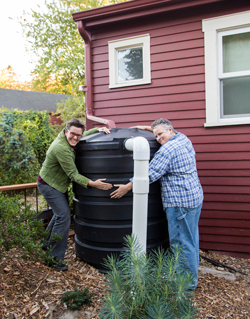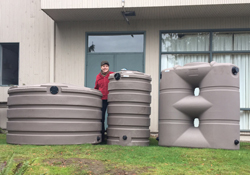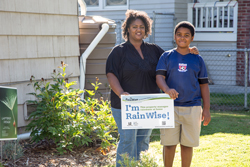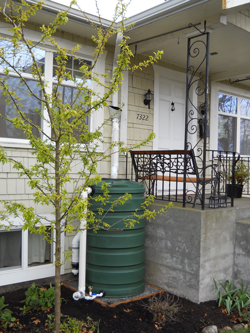
Two happy rainwater harvesters
Whether you're a Northwest gardener looking to ensure that your plants don't suffer in the long dry summer, or a business owner looking to manage stormwater runoff from your large roof, you may want to consider an old-fashioned technology: rainwater catchment with barrels or cisterns.
Not only will harvesting rainwater safeguard your garden, you’ll also be helping to keep our waterways clean, safe and full of life! When storms occur and large quantities of water go down storm drains, it can pollute local waterways. In some neighborhoods in Seattle, storm drains flow directly into sewer pipes and heavy storms can cause overflows. In the rest of King County, storm drains flow into streams and local water bodies and heavy storms can cause pollution. In both cases, by harvesting the rain that falls on your roof, you are helping keep our waterways clean!
You can buy or make a catchment system. If you have a very large roof or a lot of plants to care for, consider upgrading to a large-volume cistern which can store more water, thus providing for larger gardens and doing even more to safeguard natural ecosystems.

Rain tanks come in all shapes and sizes (Photo courtesy of Rain Dog Designs)
Grants and rebates available
If you live in certain parts of King County, you may qualify for a rebate which will cover most or all of your installation costs!
- For those within the King County Wastewater Treatment Division service area: Green Stormwater Infrastructure Mini Grants
- For those within unincorporated King County: RainScapes
- For those within some Seattle neighborhoods: RainWise
- Other incentives throughout the region

Get RainWise and you may be eligible for a rebate!
More information/general resources
- The RainWise program’s Cistern Fact Sheet.
- King County Green Building Handbook
- King County Yard Talk, Episode 10: "Waterwise Gardening." This episode covers drought tolerant landscaping, using cisterns and rain barrels and Smart Watering techniques.
- City of Seattle Department of Planning and Design’s detailed guide to designing and installing a water catchment system, including LEED benefits and examples of completed projects.
- Washington State Dept. of Ecology’s rainwater collection.
- Rainwater Harvesting (2 MB), an article about the history and technology of rainwater catchment, courtesy of Landscape Architecture Magazine.
- Saving Water Partnership, a group of local water utilities, has some useful information and resources about rainwater harvesting.
- Texas Manual on Rainwater Harvesting: The standard reference for professionals on designing rainwater catchment and reuse systems.
- Water Saving in the Garden (378 KB), some basic facts about cisterns and rain barrels from King County Wastewater Treatment Division
- A detailed Introduction to rainwater harvesting from the Ecology Action Center.
- Seattle Public Utilities’ guide to Installing a Cistern.
- American Rainfall Catchment Systems Association- links to other resources for design professionals and current news on rainwater harvesting around the US.
- Research indicates rainwater is safe for irrigating vegetables– research from Australia and WA Dept. of Ecology.
- Advice on Rain Barrel Watering.

Cisterns can fit anywhere!
Rain barrel and cistern (rain tank) sources
Following is a list of some sources to purchase rainwater catchment equipment for pick. You can also try calling your favorite local garden center and ask if they stock rain barrels or cisterns.
*Note: King County maintains this list as a courtesy to the public and does not endorse or guarantee the quality of the service offered or provided.
- Seattle Conservation Corps – City of Seattle’s vendor for rain barrels as well as 3 sizes of larger cisterns. Delivery is available within Seattle city limits for a small fee.
- Coal Creek Utility District – Barrels available in Newcastle
- IMEX - Recycled barrels (e.g., 55-gallon plastic drums) are frequently available through the online Industrial Materials Exchange. Be sure to determine what the barrels were used for previously. Do not use toxic drums.
- Rainwater Harvesting Systems
- Natural Rainwater – Rain Barrel distribution in Tacoma
- Grady Barrels – Barrels as well as larger systems
- Gardeners Supply Company
- Garden Supermart
- Garden Water Saver– Kits to make your own water barrel
- Bushman – Tanks and cisterns of all shapes and sizes
- Aquabarrel Rain Barrel
News and announcements
Check out the RainChangers campaign from Stewardship Partners!
Frequently asked questions
Your initial investment depends on how big of a project you undertake. Some factors to consider:
- How big is your catchment area (roof)?
- How big is your garden?
- How much will you be relying on irrigation rather than rain to water your plants?
- You may find this Calculator Tool useful in thinking about how big of a tank you need.
And remember, you may be eligible for financial and/or technical resources to help install a rainwater catchment system. Learn more about incentives throughout the Puget Sound region here.
Yes, depending on where you live in King County.
- For those within the King County Wastewater Treatment Division service area: Green Stormwater Infrastructure Mini Grants
- For those within unincorporated King County: RainScapes
- For those within some Seattle neighborhoods: RainWise
- Other incentives throughout the region

 Translate
Translate